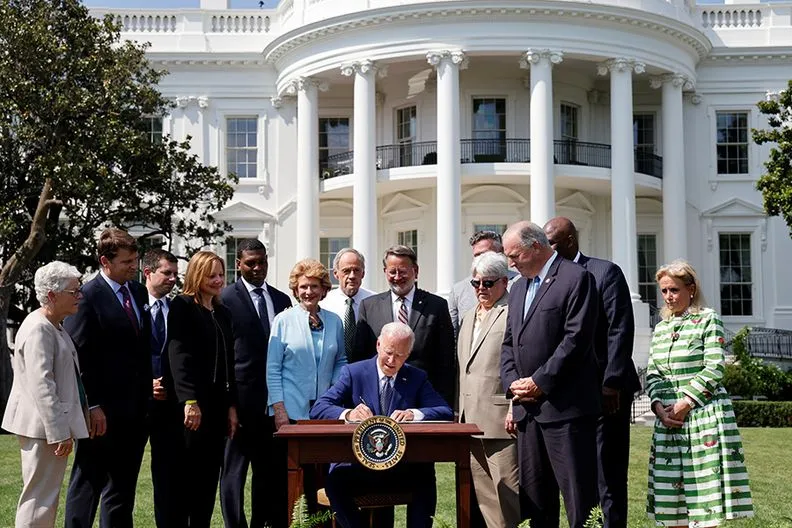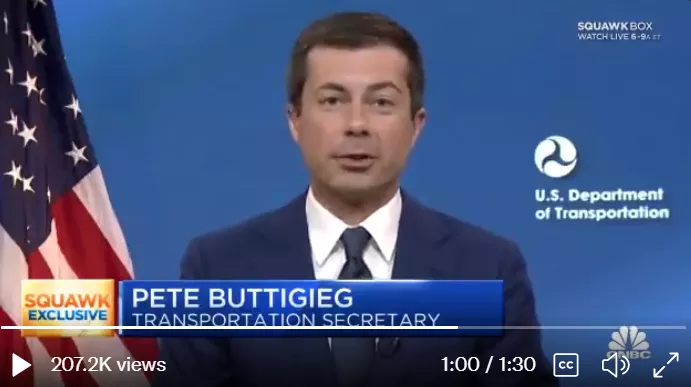Author: Li Ruiyi
The United States has proposed a grand plan to develop electric vehicles. However, Tesla may not necessarily benefit from the following policy dividends.

On August 5th, US President Biden signed an executive order (as shown above) at the White House, proposing that 50% of new vehicles sold in the United States by 2030 should be zero-emission vehicles.
Executives from General Motors, Ford, and Stellantis (the Chrysler parent company) were invited to attend the signing ceremony. However, Tesla, the global leader in electric vehicle sales, was not invited.
The issuance of this executive order will undoubtedly bring a package of policy dividends. The three major US auto giants (Ford, GM, and Chrysler), which have a huge impact on US politics, will seek more policy support. Will Tesla’s advantage in the US electric vehicle market shrink?
Biden: Develop Electric Vehicles Seriously
A new policy that will change the US automotive industry has been introduced.
The executive order that Biden signed at the White House proposed an unprecedented and grand plan-to reach the goal that half of the vehicles sold in the United States are zero-emission by 2030. Zero-emission electric vehicles here include pure electric, fuel cell vehicles, and plug-in hybrid electric vehicles. In addition, new emission standards will be implemented for light-duty vehicles at least by 2030, and for heavy-duty vehicles, new emission standards will be implemented as early as 2027.
Before this, Biden had tweeted that “the future of the US automobile industry is electric” and “electric cars are unstoppable.” The signing of this executive order is the implementation of these statements.
Biden is pushing for the development of the US electric vehicle industry so eagerly for three reasons. Firstly, new energy vehicles have become the mainstream development trend, and internal combustion engines may become history. Secondly, clean energy and environmental protection are the key focus of the Biden government. Thirdly, the development of the US electric vehicle industry has fallen behind Europe and China.
As of 2020, the penetration rate of electric vehicles in the United States was only 2.2%, while the data for China and Europe were 5.4% and 11.41%, respectively. According to the International Energy Agency (IEA), the United States accounts for only 17% of the total of 10.2 million electric vehicles worldwide. China accounts for 44% (more than 4.5 million vehicles) of the world’s electric vehicles, and Europe accounts for about 31% of nearly 3.2 million vehicles. The growth rate of electric vehicles in the United States also lags far behind Europe and China. From 2016 to 2020, the compound annual growth rate in Europe was 60%, in China it was 36%, and in the United States it was 17%.Translate the Chinese Markdown text below into English Markdown text with professional approach, keeping the HTML tags inside the Markdown and outputting the result only.
In addition, the electric vehicle industry in Europe and China is still developing rapidly, and penetration rate is constantly increasing. According to the statistics of China Association of Automobile Manufacturers, in May 2021, China’s new energy vehicle market penetration rate exceeded 10%. The penetration rate of new energy vehicles in eight European countries led by England, France, and Germany has increased to 19.7%.

US Transportation Secretary Pete Buttigieg (pictured above) also stated, “We have to take action. The goal of making half our new cars electric by the end of the decade is not only desirable, it is necessary to meet the climate crisis of our time.”
The Three Major Car Giants Declare Their Support
The executive order proposed by Biden is not legally binding. However, this goal has won the support of major US and foreign car manufacturers.
After the order was issued, General Motors, Ford, and Stellantis issued statements responding to this goal.
The statement said that their common goal is to achieve a 40-50% share of electric vehicles in US new car sales by 2030, bringing the United States closer to a zero-emission future in line with Paris climate goals.
General Motors has committed to launching 30 new electric vehicles by 2025 (over 20 new models in the US market).
Ford plans to increase the proportion of pure electric vehicle sales to 40% by 2030.
Stellantis Group previously committed to investing at least 30 billion euros in the field of electric vehicles by 2025. According to the company’s vision, 98% of Stellantis Group’s models in the European and North American markets will have electrification options by 2025.
However, after expressing their support, the three giants immediately began to “negotiate”.
The statement said that this represents a huge transformation in today’s US market. However, this transformation can only be achieved by timely implementation of the comprehensive electrification policies promised in the “Build Back Better Plan” by the government, including purchasing incentives, a comprehensive charging network that can support millions of electric vehicles, investment in research and development, and incentives to expand the manufacturing and supply chain of electric vehicles in the United States.
In other words, they will not do it unless the government gives incentives for purchasing, charging, research, development, production and supply chain for electric vehicles.
The statement said, “We look forward to working with the Biden administration and Congress, state and local governments to develop policies that will achieve these ambitious goals.”
In addition, the three major US automakers emphasized the role of the United Auto Workers (UAW) union in this electrification transformation.## Can Tesla Benefit from the Policy Dividends?
When Biden signed the executive order, the three major US automakers were present, but the US electric car sales champion Tesla was not invited.
Tesla CEO Elon Musk expressed his feelings frankly on Twitter, saying, “It seems strange that Tesla was not invited.”
White House press secretary Jen Psaki was asked during a press conference whether Tesla was excluded from the event because its employees did not join the UAW union.
Psaki replied, “I hope you can draw your own conclusion.” The White House statement said that the event invited companies that employ UAW members among the three major US companies. The statement also said: “We certainly welcome all the efforts made by car manufacturers who recognize the potential of electric vehicles and support the achievement of President Biden’s goals, including car manufacturers that are committed to fleet electrification and reducing emissions.”
In the message released by the White House, UAW President Ray Curry also said: “As countries are competing to build future cars, we are at a critical moment in the automotive industry. We need to invest in the United States. The emissions standards announced today bring more certainty and better planning for the automotive industry and UAW members in the future.”
It can be seen that Biden had the conditions to issue this new policy due to UAW’s support. Musk had publicly opposed the creation of a union at Tesla’s factories. In March of this year, the US federal government’s labor relations commission even asked Musk to delete a Twitter post because it threatened the internal labor organizer at Tesla.
Biden’s “Build Back Better Plan” aims to revitalize American manufacturing and support labor. Musk’s attitude towards unions is likely an important reason why he was not invited this time.
If US electric car policies favor companies with unions, that is, the three major automakers, it will not be a good thing for Tesla.In the U.S. electric vehicle market, the three auto giants who attended the signing ceremony have already begun to eat away at some of Tesla’s market share, although their share is still only a small part. Today, General Motors and Ford are still building electric vehicle manufacturing plants and researching how to win consumer confidence. In contrast to this, relying on its 17-year focus on pure electric car business, Tesla not only dominates the U.S. electric vehicle market, but has also become one of the highest-valued automakers in the world.
Earlier, the Biden administration proposed a multi-trillion-dollar infrastructure plan, with the construction of an electric car charging station network as an important component, with funds of $7.5 billion.
In order to get a piece of that $7.5 billion. Tesla announced that it would open up their supercharging stations to other electric vehicle brands. This is because the charging network construction plan requires that charging stations that want to receive government support must support more than one electric vehicle brand.
In terms of charging station facilities in the United States, Tesla is in the leading position, while Ford and General Motors are still catching up with Tesla. According to a report by automotive industry researcher Wagner, as of the end of February this year, the number of electric vehicle charging stations in the United States was less than 100,000. However, Tesla’s official website shows that the company has built up to 25,000 supercharging stations in the United States.
President Biden’s plan emphasizes keeping electric cars “made in America.” While Tesla has a factory in the United States and is building its largest factory ever, it also likes to build factories overseas. It already has a factory in Shanghai and is building one in Germany, and plans to build factories in India and Brazil. Musk has also said that Tesla’s cost in Shanghai is nearly 65% lower than in the United States.
In addition, Tesla’s attitude towards unions also makes it less favored by the Biden administration.
In the future, U.S. electric vehicle industry policy benefits may lean towards General Motors, Ford, and Chrysler to help them quickly develop electric vehicles and achieve the goal of 50% electric vehicle sales by 2030. As a result, Tesla’s advantage in the U.S. electric car industry, where it is leading, is likely to shrink.
As of the close on August 5th, General Motors and Ford were both up about 3%, closing at $54.44 and $13.71, respectively. Tesla rose 0.52% to $714.63 per share.
The positive gap seems to have been reflected in the stock price gains.
This article is a translation by ChatGPT of a Chinese report from 42HOW. If you have any questions about it, please email bd@42how.com.